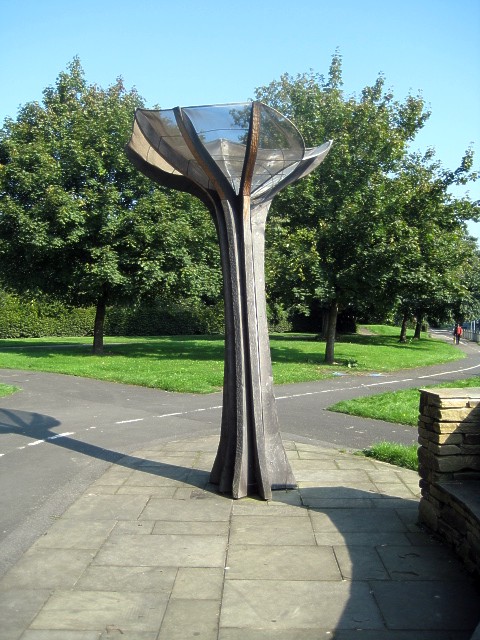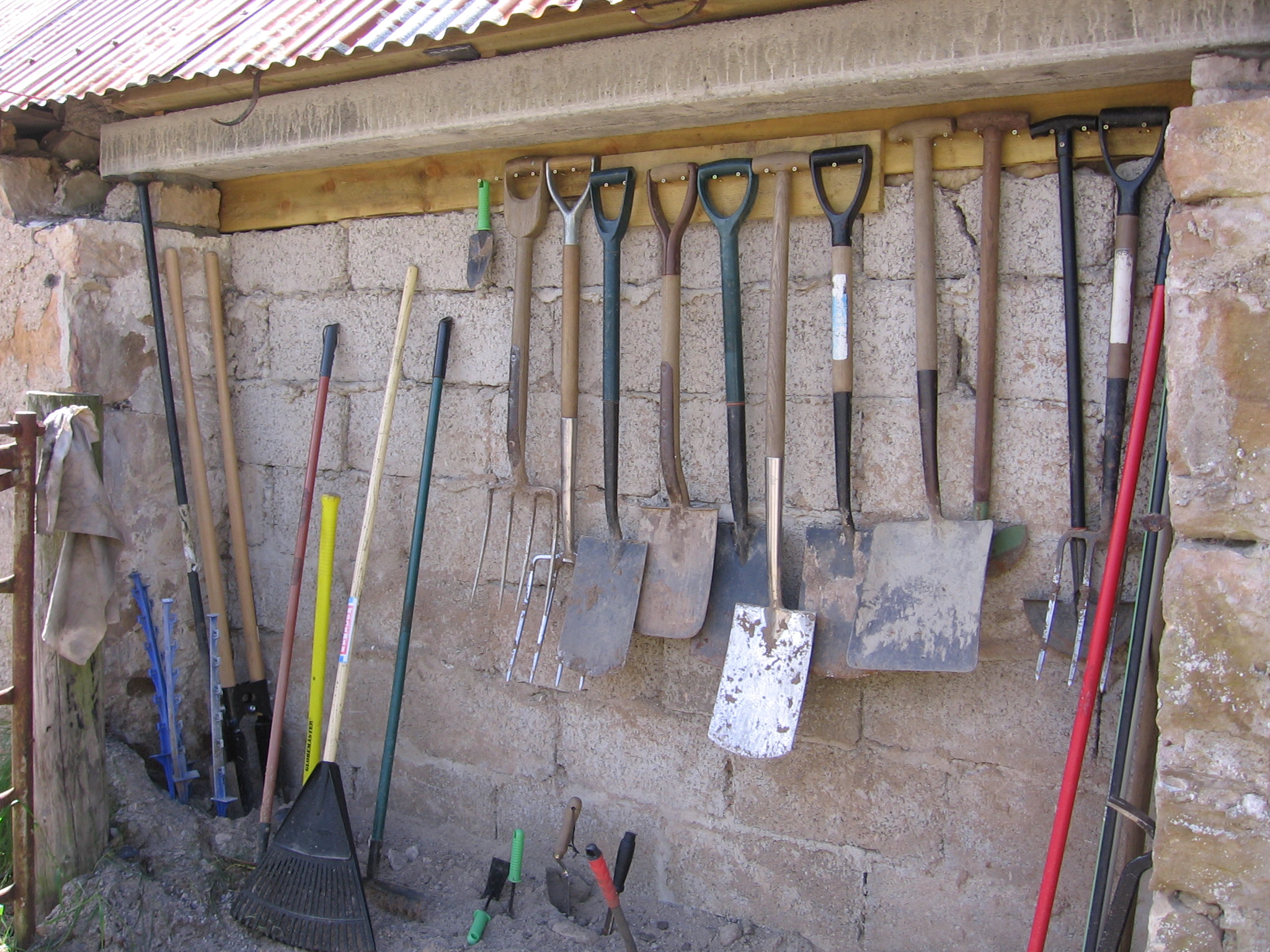|
Rhubarb Forcer
Rhubarb forcers are bell-shaped pots with a lidded opening at the top, used to cover rhubarb to limit photosynthesis. They encourage the plant to grow early in the season and also to produce blanched stems. The pots are placed over two- to three-year-old rhubarb crowns during winter or very early spring. Once shoots appear the lid is taken off, causing them to grow towards the light. Around high and wide without the lid, they are traditionally made of terracotta but can be as simple as an upside down plastic bucket. See also * Rhubarb Triangle The Rhubarb Triangle is a area of West Yorkshire, England between Wakefield, Morley and Rothwell famous for producing early forced rhubarb. It includes Kirkhamgate, East Ardsley, Stanley, Lofthouse and Carlton. The Rhubarb Triangle was origi ... References External links Forcing rhubarb in winterHow to force rhubarb Gardening tools Rhubarb {{Horticulture-stub ... [...More Info...] [...Related Items...] OR: [Wikipedia] [Google] [Baidu] |
Terracotta Rhubarb Forcers
Terracotta, terra cotta, or terra-cotta (; ; ), in its material sense as an earthenware substrate, is a clay-based unglazed or glazed ceramic where the fired body is porous. In applied art, craft, construction, and architecture, terracotta is the term normally used for sculpture made in earthenware and also for various practical uses, including vessels (notably flower pots), water and waste water pipes, roofing tiles, bricks, and surface embellishment in building construction. The term is also used to refer to the natural brownish orange color of most terracotta. In archaeology and art history, "terracotta" is often used to describe objects such as figurines not made on a potter's wheel. Vessels and other objects that are or might be made on a wheel from the same material are called earthenware pottery; the choice of term depends on the type of object rather than the material or firing technique. Unglazed pieces, and those made for building construction and industry, are ... [...More Info...] [...Related Items...] OR: [Wikipedia] [Google] [Baidu] |
Rhubarb
Rhubarb is the fleshy, edible stalks ( petioles) of species and hybrids (culinary rhubarb) of ''Rheum'' in the family Polygonaceae, which are cooked and used for food. The whole plant – a herbaceous perennial growing from short, thick rhizomes – is also called rhubarb. Historically, different plants have been called "rhubarb" in English. The large, triangular leaves contain high levels of oxalic acid and anthrone glycosides, making them inedible. The small flowers are grouped in large compound leafy greenish-white to rose-red inflorescences. The precise origin of culinary rhubarb is unknown. The species ''Rheum rhabarbarum'' (syn. ''R. undulatum'') and '' R. rhaponticum'' were grown in Europe before the 18th century and used for medicinal purposes. By the early 18th century, these two species and a possible hybrid of unknown origin, ''R.'' × ''hybridum'', were grown as vegetable crops in England and Scandinavia. They readily hybridize, and culinary rh ... [...More Info...] [...Related Items...] OR: [Wikipedia] [Google] [Baidu] |
Rhubarb
Rhubarb is the fleshy, edible stalks ( petioles) of species and hybrids (culinary rhubarb) of ''Rheum'' in the family Polygonaceae, which are cooked and used for food. The whole plant – a herbaceous perennial growing from short, thick rhizomes – is also called rhubarb. Historically, different plants have been called "rhubarb" in English. The large, triangular leaves contain high levels of oxalic acid and anthrone glycosides, making them inedible. The small flowers are grouped in large compound leafy greenish-white to rose-red inflorescences. The precise origin of culinary rhubarb is unknown. The species ''Rheum rhabarbarum'' (syn. ''R. undulatum'') and '' R. rhaponticum'' were grown in Europe before the 18th century and used for medicinal purposes. By the early 18th century, these two species and a possible hybrid of unknown origin, ''R.'' × ''hybridum'', were grown as vegetable crops in England and Scandinavia. They readily hybridize, and culinary rh ... [...More Info...] [...Related Items...] OR: [Wikipedia] [Google] [Baidu] |
Shoot
In botany, a plant shoot consists of any plant stem together with its appendages, leaves and lateral buds, flowering stems, and flower buds. The new growth from seed germination that grows upward is a shoot where leaves will develop. In the spring, perennial plant shoots are the new growth that grows from the ground in herbaceous plants or the new stem or flower growth that grows on woody plants. In everyday speech, shoots are often synonymous with stems. Stems, which are an integral component of shoots, provide an axis for buds, fruits, and leaves. Young shoots are often eaten by animals because the fibers in the new growth have not yet completed secondary cell wall development, making the young shoots softer and easier to chew and digest. As shoots grow and age, the cells develop secondary cell walls that have a hard and tough structure. Some plants (e.g. bracken) produce toxins that make their shoots inedible or less palatable. File:Cucumber leaf.jpg, The shoot of a cucu ... [...More Info...] [...Related Items...] OR: [Wikipedia] [Google] [Baidu] |
Terracotta
Terracotta, terra cotta, or terra-cotta (; ; ), in its material sense as an earthenware substrate, is a clay-based ceramic glaze, unglazed or glazed ceramic where the pottery firing, fired body is porous. In applied art, craft, construction, and architecture, terracotta is the term normally used for sculpture made in earthenware and also for various practical uses, including bowl (vessel), vessels (notably flower pots), water and waste water pipes, tile, roofing tiles, bricks, and surface embellishment in building construction. The term is also used to refer to the natural Terra cotta (color), brownish orange color of most terracotta. In archaeology and art history, "terracotta" is often used to describe objects such as figurines not made on a potter's wheel. Vessels and other objects that are or might be made on a wheel from the same material are called earthenware pottery; the choice of term depends on the type of object rather than the material or firing technique. Unglazed ... [...More Info...] [...Related Items...] OR: [Wikipedia] [Google] [Baidu] |
Telegraph
Telegraphy is the long-distance transmission of messages where the sender uses symbolic codes, known to the recipient, rather than a physical exchange of an object bearing the message. Thus flag semaphore is a method of telegraphy, whereas pigeon post is not. Ancient signalling systems, although sometimes quite extensive and sophisticated as in China, were generally not capable of transmitting arbitrary text messages. Possible messages were fixed and predetermined and such systems are thus not true telegraphs. The earliest true telegraph put into widespread use was the optical telegraph of Claude Chappe, invented in the late 18th century. The system was used extensively in France, and European nations occupied by France, during the Napoleonic era. The electric telegraph started to replace the optical telegraph in the mid-19th century. It was first taken up in Britain in the form of the Cooke and Wheatstone telegraph, initially used mostly as an aid to railway signalling. Th ... [...More Info...] [...Related Items...] OR: [Wikipedia] [Google] [Baidu] |
Telegraph Media Group
Telegraph Media Group Limited (TMG; previously the Telegraph Group) is the proprietor of ''The Daily Telegraph'' and ''The Sunday Telegraph''. It is a subsidiary of Press Holdings. David and Frederick Barclay acquired the group on 30 July 2004, after months of intense bidding and lawsuits, from Hollinger Inc. of Toronto, Canada, the newspaper group controlled by the Canadian/American businessman Conrad Black. In 2015, TMG made an operating profit of £51 million. Profits before tax were £47m, and turnover for the 53 weeks up to 3 January 2016 was £319m, according to unaudited accounts leaked to ''The Guardian''. If these figures are accurate, then this was an increase from 2014 levels on both accounts. Telegraph Media Group operates as a multimedia news company. The holding publishes daily and weekly publications in printed and electronic versions, which provide news on politics, obituaries, sports, finance, lifestyle, travel, health, culture, technology, fashion and cars. T ... [...More Info...] [...Related Items...] OR: [Wikipedia] [Google] [Baidu] |
Rhubarb Triangle
The Rhubarb Triangle is a area of West Yorkshire, England between Wakefield, Morley and Rothwell famous for producing early forced rhubarb. It includes Kirkhamgate, East Ardsley, Stanley, Lofthouse and Carlton. The Rhubarb Triangle was originally much bigger, covering an area between Leeds, Bradford and Wakefield. From the 1900s to 1930s, the rhubarb industry expanded and at its peak covered an area of about . Rhubarb is native to Siberia and thrives in the wet cold winters in Yorkshire. West Yorkshire once produced 90% of the world's winter forced rhubarb from the forcing sheds that were common across the fields there. In 2010, Yorkshire Forced Rhubarb was awarded Protected Designation of Origin (PDO) status by the European Commission’s Protected Food Name scheme after being recommended by Department for Environment, Food and Rural Affairs (Defra). Cultivation The cultivation method for forced rhubarb was developed in the early 1800s. The fields were fertilised with l ... [...More Info...] [...Related Items...] OR: [Wikipedia] [Google] [Baidu] |
Gardening Tools
A garden tool is any one of many tools made for gardening and landscaping, which overlap with the range of tools made for agriculture and horticulture. Garden tools can be divided into hand tools and power tools. Hand tools Today's garden tools originated with the earliest agricultural implements used by humans. Examples include the hatchet, axe, sickle, scythe, pitchfork, spade, shovel, trowel, hoe, fork, and rake. In some places, the machete is common. The earliest tools were made variously of wood, flint, metal, tin, and bone. The development of metalworking, first in copper and later in bronze, iron, and steel, produced today's durable tools, including such efficient cutting tools as pruning shears (secateurs – for example anvil pruners), grass shears, and loppers. Increasing use of modern alloys allows many tools to be made both stronger and lighter, making them more durable and easier to use. Ergonomics Some modern tool designs reflect ergonomic considerations, be ... [...More Info...] [...Related Items...] OR: [Wikipedia] [Google] [Baidu] |
.jpg)
_Frambozenrood_bloeiwijze.jpg)


